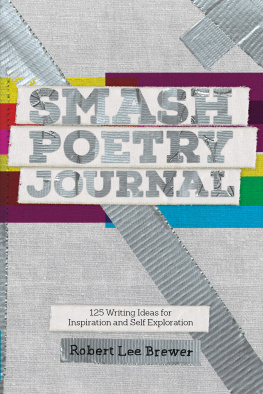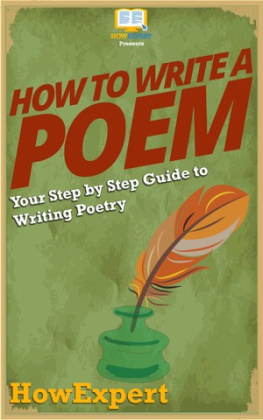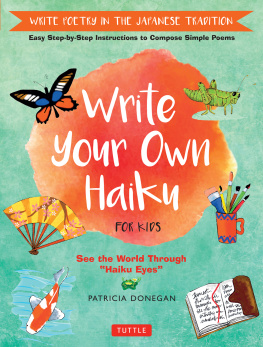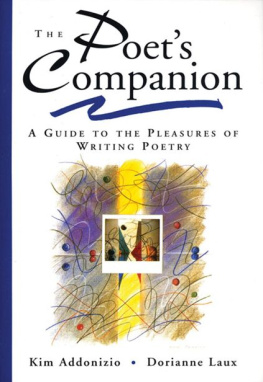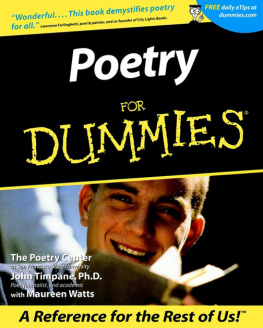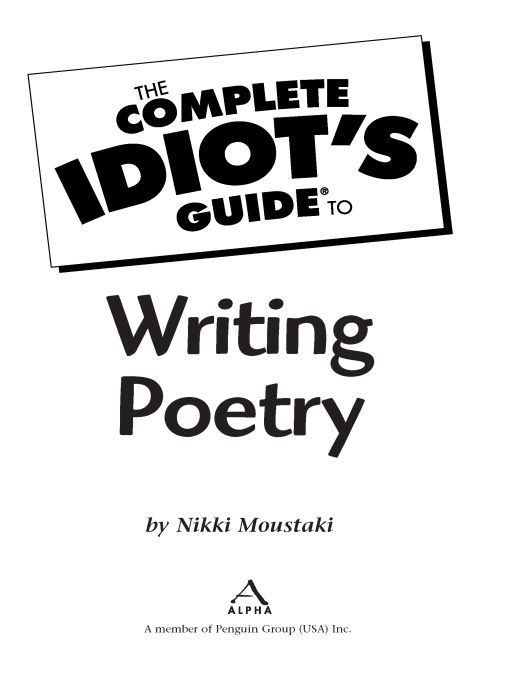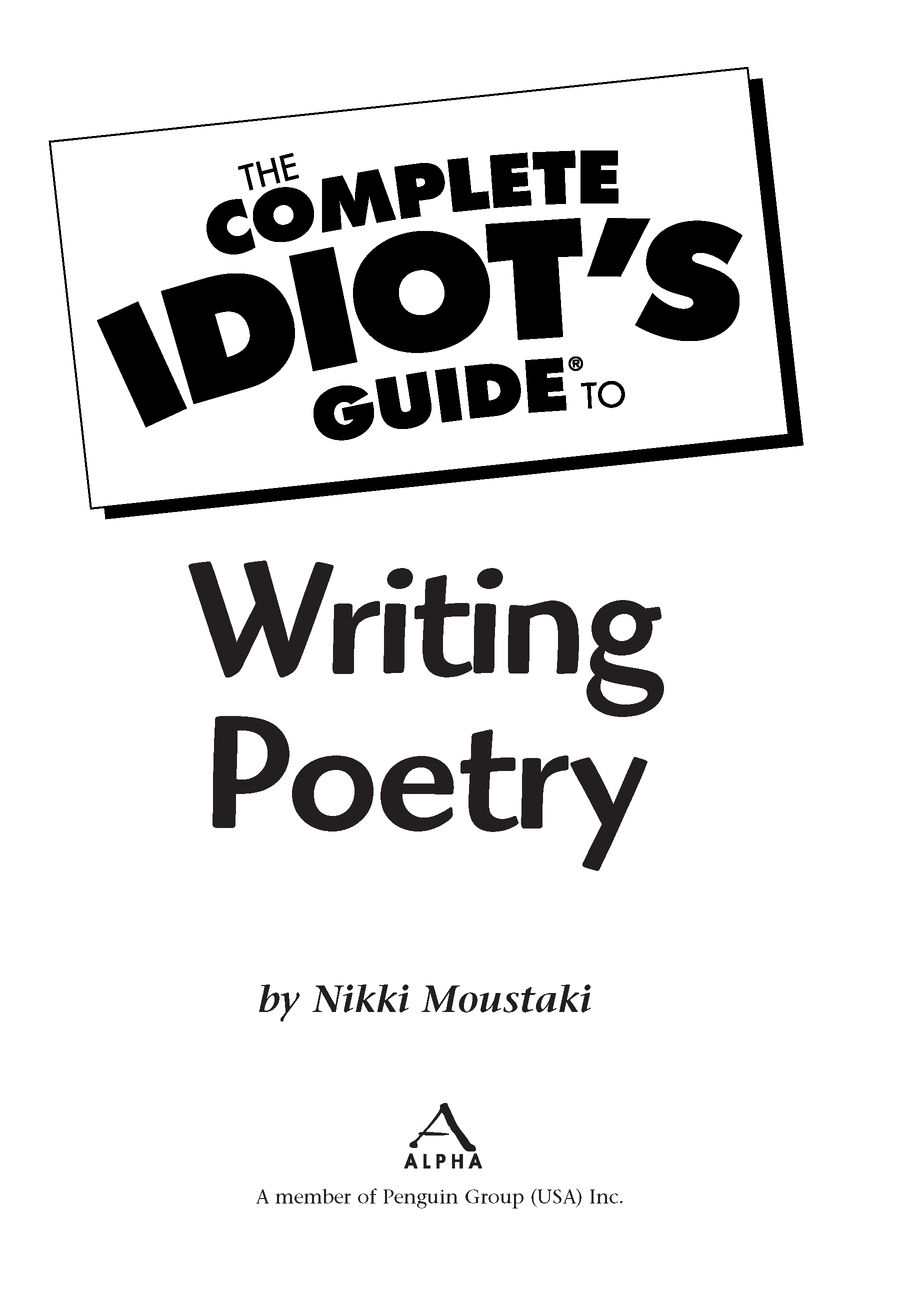Table of Contents
Publisher
Marie Butler-Knight
Product Manager
Phil Kitchel
Managing Editor
Jennifer Chisholm
Senior Acquisitions Editor
Randy Ladenheim-Gil
Development Editor
Suzanne LeVert
Senior Production Editor
Christy Wagner
Copy Editor
Jan Zunkel
Illustrator
Jody Schaeffer
Cover Designers
Mike Freeland
Kevin Spear
Book Designers
Scott Cook and Amy Adams of DesignLab
Indexer
Angie Bess
Foreword
A few years ago I passed a bookstore window in which was displayed a pyramid of books that had Idiots or Dummies in the title. I immediately had the thought of composing, perhaps in collaboration with my chum Jim, just such a primer on Americas most famously difficult poet. My poem of the dayI was experimenting with writing a poem every day, a procedure I recommend highly to aspiring writersbegan with the lines, Maybe Jim Cummins and I / will write John Ashbery / for Dummies, followed with a sequence of other Maybe clauses. This seemed to me the perfect exposition of the idea, rendering superfluous the composition of the actual book.
A book on writing poetry aimed at the idiot audience seems, on the other hand, not only a reasonable proposition but an inevitable development, one to be welcomed, especially when the writer turns out to be as energetic and imaginative as Nikki Moustaki. The intended reader of The Complete Idiots Guide to Writing Poetry is neither a complete idiot nor a partial one but an open-minded person of good will who will tolerate being called anything if youll just consent to speak in plain English that cats and dogs can understand. The fact that one day on a visit to John Ashbery I saw The Complete Idiots Guide to the Internet on the coffee table may prove my point.
It seems to me that the single best thing a book like the one you hold in your hands can do is to generate enthusiasm and provide you with ideas for how to convert that enthusiasm into poetry. I have long believed that inspiration comes not as a lightning bolt but as the result of the workings of our hearts and minds. The secret of poetic composition is that you can create your own inspiration, and a clever way to do that is with exercises and assignmentssuch as the ones you will find in this book. Nikki Moustaki has borrowed the ideas of estimable poet friends such as Catherine Bowman, Denise Duhamel, Campbell McGrath, Maureen Seaton, Reginald Shepherd. What assignments do they give themselves to jump-start their imaginations? You will find poems for imitation, practical advice on everything from revision to reading in public, an introduction to poetic terms and conventions, and answers to questions the idiot side of your brain has always wanted to ask: Why are there so many rules in poetry? How do you know if what you are writing is good? What is meter?
Good writing begins with good reading and is followed by workhard, disciplined, sometimes daily labor. There is no denying the element of truth in Thomas Alva Edisons definition of genius as 10 percent inspiration next to 90 percent perspiration. Yes, but sometimes the work can be fun. Thats the ultimate logic behind the whole range of poetic regulations from the complicated rules of the sestina form to the uses of metaphor and simile: These are some of the ways in which the imagination turns a feat of labor into an activity yielding pleasures both immediate and long-lasting.
Enjoy the ride.
David Lehman
David Lehman is the author of four poetry books, including The Daily Mirror: A Journal in Poetry, which includes a selection of 150 of the poems he wrote after resolving to write one a day. Lehman initiated The Best American Poetry in 1988 and continues as the series editor of this distinguished annual anthology. He has served on the core faculty of the graduate writing programs at Bennington College and the New School since the inception of the programs. He also teaches a Great Poems honors course at New York University.
Introduction
A journey of a thousand miles begins with a single step.
Laozi
The art of poetry has been around for thousands of yearsa poet beginning today has a lot of catching up to do! To write poetry is to become a part of a very large clique composed of some of the greatest thinkers and writers of all time. When you write poetry, youre casting a spell that conjures all of them. Youre a member of a pretty big party now!
Can writing poetry be taught? Or, an even more pressing question, can you learn to write poetry from reading this book and following its suggestions? Yes to both questions. Poetry is made of a certain skill set, that, when executed well, creates poetry. Sounds a little like car mechanics, doesnt it? Ill admit theres a lot more to it than just using the skills well, but you have to begin somewhere, and heres as good a place as any.
This book is designed to tap into your creativity and to teach you the initial skills (and then some!) to get you well on your way to becoming a poet. Youll find a lot to do in this bookpoetry exercises, poetic forms to try, valuable tips designed to put your creativity into action, and more. I hope you enjoy the journey. Sharpen your pencil and dig in!
What Youll Learn in This Book
This book is divided into four parts that take you though the process of developing your poetic potential. Youll learn about the whys and wherefores of poetry, discover the basic skills needed to write it, and get practical tips on publishing your own poems. Heres what the four parts of this book cover:
In Part 1, What Is Poetry and How Do I Write It? youll learn the basic elements of poetry, how to get started, how to conquer the fear of the blank page, journaling, and more. You will see if you have what it takes to be a poet, and youll get a lot of encouragement along the way.
Part 2, Opening the Stanzas Door: Entering Poetry, teaches you the set of skills that a poet practices to create his or her art: metaphor, repetition, music, meter, and more. This part details these skills and gives you practical advice on how to use them. You will also find a lot of exercises to get you using the skills right away, and examples to help you see if youre doing them right.
Part 3, Popular Types of Poems and How to Write Them, verses you in a variety of ways to write poems, from the love poem to the sonnet. You will get a crash course on popular fixed forms, as well as tips and hints on writing other types of conventional poems. There are thousands of ways to write a poemhere are a few.
In Part 4, Poetry and Practicality, youll learn how to avoid poetrys pitfalls, obtain valuable revision techniques, get advice on workshops and graduate schools, and gain some enlightenment on the wonderful world of publishing your own poems, including a complete how-to section and an insiders look at getting published. Youll also find a chapter of original exercises from poets who teach, as well as a short course in appreciating poetry. Finally, a Frequently Asked Questions chapter will answer those little things you still need to know.
Theres a glossary of poetic terms following Part 4 that explains key terms and gives their definitions. Finally, theres an appendix containing the information to valuable resources such as books, magazines, and Web sites specially created for poets.



